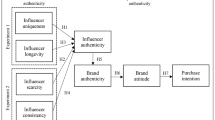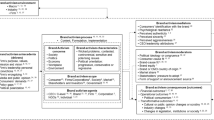Abstract
A city's brand is increasingly considered an important asset for urban development and an effective tool for cities to distinguish themselves and improve their positioning. The introduction of corporate-level marketing concepts and, especially, corporate branding has significantly contributed towards the development of a city branding theory. In practice, however, there is an evident confusion of a wide branding strategy with one of its components, namely the design of a new logo and slogan or, at best, the development of a promotional campaign. This paper first describes the rise of city branding and the reasons of its popularity and, after a short review of the basic elements of corporate branding, it goes on to identify essential similarities between these two forms of branding. It finally detects the need to adapt any branding tools to the needs of cities and addresses the necessity of a comprehensive city brand management framework.
Similar content being viewed by others
References
Morgan, N., Pritchard, A. and Pride, R., (eds.) (2002) ‘Destination Branding: Creating the Unique Destination Proposition’, Butterworth-Heinemann, Oxford, p. 3.
Kavaratzis, M. (2005) ‘Place branding: A review of trends and conceptual models’, The Marketing Review, Vol. 5, No. 4, pp. 329–342.
Kavaratzis, M. and Ashworth, G. J. (2005) ‘City branding: An effective assertion of identity or a transitory marketing trick’, Tijdschrift Voor Economische en Sociale Geografie, Vol. 96, No. 5, pp. 506–514.
Freire, J. R. (2005) ‘Geo-branding, are we talking nonsense? A theoretical reflection on brands applied to places’, Place Branding, Vol. 1, No. 4, 347–362.
Anholt, S. (2007) ‘Competitive Identity: The New Brand Management for Nations, Cities and Regions’, Palgrave Macmillan, Basingstoke.
Anholt, S. (2002) ‘Foreword to the special issue on place branding’, Journal of Brand Management, Vol. 9, No. 4–5, pp. 229–239.
Gilmore, F. (2001) ‘A country—can it be repositioned? Spain—The success story of country branding’, Journal of Brand Management, Vol. 9, No. 4–5, pp. 281–293.
Papadopoulos, N. and Heslop, L. (2002) ‘Country equity and country branding: Problems and prospects’, Journal of Brand Management, Vol. 9, No. 4/5, pp. 294–315.
Hannigan, J. (2003) ‘Symposium on branding, the entertainment economy and urban place building: Introduction’, International Journal of Urban and Regional Research, Vol. 27, No. 2, pp. 352–360.
Evans, G. (2003) ‘Hard branding the cultural city: From Prado to Prada’, International Journal of Urban and Regional Research, Vol. 27, No. 2, pp. 417–440.
Morgan et al., ref. 1, above.
Hankinson, G. (2001) ‘Location branding: A study of the branding practices of 12 English cities’, Journal of Brand Management, Vol. 9, No. 2, pp. 127–142.
Hankinson, G. (2004) ‘Relational network brands: Towards a conceptual model of place brands’, Journal of Vacation Marketing, Vol. 10, No. 2, pp. 109–121.
Hankinson, ref 12, above, p. 110.
Hankinson, G. (2007) ‘The management of destination brands: Five guiding principles based on recent developments in corporate branding theory’, Journal of Brand Management, Vol. 14, No. 3, pp. 240–254.
Trueman, M., Cornelius, N. and Killingbeck-Widdup, A. J. (2007) ‘Urban corridors and the lost city: Overcoming negative perceptions to reposition city brands’, Journal of Brand Management, Vol. 15, No. 1, pp. 20–31.
Kavaratzis, M. (2004) ‘From city marketing to city branding: Towards a theoretical framework for developing city brands’, Place Branding, Vol. 1, No. 1, pp. 58–73.
Trueman, M., Klemm, M. and Giroud, A. (2004) ‘Can a city communicate? Bradford as a corporate brand’, Corporate Communications: An International Journal, Vol. 9, No. 4, pp. 317–330.
Rainisto, S. K. (2003) ‘Success factors of place marketing: A study of place marketing practices in Northern Europe and the United States’, Doctoral Dissertation, Helsinki University of Technology, Institute of Strategy and International Business.
Kavaratzis, M. and Ashworth, G. J. (2007) ‘Partners in coffeeshops, canals and commerce: Marketing the city of Amsterdam’, Cities, Vol. 24, No. 1, pp. 6–25.
Saren, M. (2007) ‘Marketing is everything: The view from the street’, Marketing Intelligence and Planning, Vol. 25, No. 1, pp. 11–16.
Veloutsou, C., Saren, M. and Tzokas, N. (2002) ‘Relationship marketing: What if’, European Journal of Marketing, Vol. 36, No. 4, pp. 433–449.
Hankinson, ref 13 above.
Ashworth, G. J. (2001) ‘The communication of the brand images of cities’, Paper presented at the Universidad Internacional Menendez Pelayo Conference: The Construction and Communication of the Brand Images of Cities, Valencia, Spain.
Knox, S. and Bickerton, D. (2003) ‘The six conventions of corporate branding’, European Journal of Marketing, Vol. 37, No. 7–8, pp. 998–1016.
Simoes, C. and Dibb, S. (2001) ‘Rethinking the brand concept: New brand orientation’, Corporate Communications: An International Journal, Vol. 6, No. 4, pp. 217–224.
Balmer, J. M. T. and Gray, E. R. (2003) ‘Corporate brands: What are they? What of them’, European Journal of Marketing, Vol. 37, No. 7–8, pp. 972–997.
Ibid., p. 975.
Ibid.
Balmer, J. M. T. (2002) ‘Of identities lost and found’, International Studies of Management and Organisation, Vol. 32, No. 3, pp. 10–27.
van Riel, C. B. M. and Balmer, J. M. T. (1997) ‘Corporate identity: The concept, its measurement and management’, European Journal of Marketing, Vol. 31, No. 5–6, pp. 340–355.
Simoes and Dibb, ref. 26, above.
Balmer, ref. 30, above.
Ibid.
Ibid.
Balmer, J. M. T. and Greyser, S. A. (2002) ‘Managing the multiple identities of the corporation’, California Management Review, Vol. 44, No. 3, pp. 72–86.
Ibid.
Ibid.
Ibid.
Knox and Bickerton, ref. 25 above, p. 1013.
Simoes and Dibb, ref. 26 above.
Balmer, J. M. T. (2001) ‘Corporate identity, corporate branding and corporate marketing: Seeing through the fog’, European Journal of Marketing, Vol. 35, No. 3–4, pp. 248–291.
Knox and Bickerton, ref. 25 above.
Ibid.
Simoes and Dibb, ref. 26 above.
Hatz, M. J. and Schultz, M. (2001) ‘Are the strategic stars aligned for your corporate brand’, Harvard Business Review, Vol. 79, No. 2, pp. 128–134.
Kapferer, J. N. (1997) ‘Strategic Brand Management’, Kogan Page, London.
Aaker, D. A. (1996) ‘Building Strong Brands’, Free Press, New York.
Rainisto, ref. 19 above.
Balmer and Gray, ref. 27 above.
Ashworth, G. J. and Voogd, H. (1990) ‘Selling the City: Marketing Approaches in Public Sector Urban Planning’, Belhaven Press, London.
Kotler, P., Asplund, C., Rein, I. and Heider, D. (1999) ‘Marketing Places Europe: Attracting Investments, Industries, Residents and Visitors to European Cities, Communities, Regions and Nations’, Pearson Education Ltd, London.
Ashworth 2001, ref 24, above.
Trueman et al., ref. 16 above.
Ave, G. (1994) ‘Urban planning and strategic urban marketing in Europe’, in Ave, G. and Corsico, F. (eds.) ‘Marketing Urbano International Conference’, Edizioni Torino Incontra, Torino.
Dematteis, G. (1994) ‘Urban identity, city image and urban marketing’, in Braun, G.O. (ed.) ‘Managing and Marketing of Urban Development and Urban Life’, Dietrich Reimer Verlag, Berlin.
Kavaratzis, ref. 17 above.
Trueman et al., ref 16 above.
Hankinson, ref 15 above.
Kavaratzis, ref 17 above.
Anholt, ref 6 above.
Hankinson, ref 59 above.
Ibid., p. 251.
Trueman et al., ref. 18 above.
Balmer, ref. 30 above.
Trueman et al., ref. 18 above, p. 328.
Rainisto, ref. 19 above, p. 50.
Ibid, p. 52.
Kerr, G. (2006) ‘From destination brand to location brand’, Journal of Brand Management, Vol. 13, No. 4/5, pp. 276–283.
Caldwell, N. and Freire, J. R. (2004) ‘The differences between branding a country, a region and a city: Applying the Brand Box model’, Journal of Brand Management, Vol. 12, No. 1, pp. 50–61.
Ibid.
Therkelsen, A. and Halkier, H. (2004) ‘Umbrella place branding: A study of friendly exoticism and exotic friendliness in coordinated national tourism and investment promotion’, Discussion Paper 26/2004, SPIRIT, Aalborg University, p. 1.
Eg Ashworth and Voogd, ref 51 above.
Anholt, ref. 5 above, p. 9.
Rainisto, ref. 19 above.
Anholt, S. (2006) ‘The Anholt-GMI city brands index: How the world sees the world's cities’, Place Branding, Vol. 2, No. 1, pp. 18–31.
Cai, L. A. (2002) ‘Cooperative branding for rural destinations’, Annals of Tourism Research, Vol. 29, No. 3, pp. 720–742.
Ibid.
Kavaratzis, ref. 17 above.
Balmer, ref. 30 above.
Hankinson, ref. 13, above.
Ibid., p. 111.
Hankinson, ref. 59 above.
Ibid., p. 251.
Author information
Authors and Affiliations
Corresponding author
Additional information
1was educated at St. John's College Cambrige (BA, 1962), University of Reading (MPhil, 1967), Birkbeck College, University of London (PhD,.1974). He has taught at the University of Wales, Cardiff Department of Geography, Cyncoed. 1966–1969; University of Portsmouth, Department of Geography, 1969–1979. University of Groningen, Faculty of Spatial Sciences 1979– . Since 1994, he is Professor of Heritage Management and Urban Tourism in the Department of Planning, Rijksuniversiteit Groningen, the Netherlands.
2was born in Athens, Greece. He studied business administration in the University of Piraeus in Greece and then obtained an MSc in Marketing from the University of Stirling in Scotland. In 2004 he joined the Urban and Regional Studies Institute (URSI) of the University of Groningen. He is completing his PhD on city marketing in Europe.
Rights and permissions
About this article
Cite this article
Ashworth, G., Kavaratzis, M. Beyond the logo: Brand management for cities. J Brand Manag 16, 520–531 (2009). https://doi.org/10.1057/palgrave.bm.2550133
Received:
Revised:
Published:
Issue Date:
DOI: https://doi.org/10.1057/palgrave.bm.2550133




